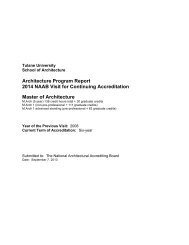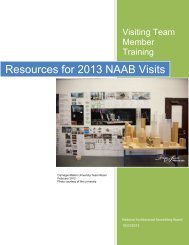Architecture Program Report Tulane University New Orleans ...
Architecture Program Report Tulane University New Orleans ...
Architecture Program Report Tulane University New Orleans ...
Create successful ePaper yourself
Turn your PDF publications into a flip-book with our unique Google optimized e-Paper software.
students and faculty have gained.<br />
Furthermore, with regard to transitions, the shift from manual to digital<br />
methods of representation has been a major part of the school’s growth in the<br />
last 5 years. Digital design was fully introduced into the school after Katrina with<br />
the modified curriculum, which was tailored to address the education of architects<br />
in the digital present and future. We believe it is critical to understand and<br />
evaluate what has become the digital revolution in architecture and its<br />
subsequent effect on architectural education.<br />
While the majority of the experiences in the semester after the hurricane<br />
were beneficial and the new curriculum has positively integrated digital design<br />
into the school, the school’s transition has not been without its own growing<br />
pains. Our student body is divided into those students who began studying<br />
before the hurricane and those who began after, those whose processes stem<br />
from the drawing board and those whose stem from the mouse. We believe that<br />
the balance between manual and digital processes should be integrated, and that<br />
methodological values should be continually questioned with regard to the<br />
changes in our profession.<br />
The design studio is at the center of every architecture students’ core<br />
curriculum. Learning in studio is radically different from other types of academic<br />
experiences that are more common throughout the university as a whole. Studio<br />
culture fosters intellectual and personal diversity. It is a collective experience that<br />
proceeds from the individual to the group as a whole. Within the context of the<br />
university education, it is perhaps the most unique and effective means of<br />
learning; it is at the same time all encompassing of other disciplines and yet very<br />
distinctive. We endorse the curriculum’s continual inclusion of classes outside of<br />
architecture. It is critical to find a common language with students pursuing other<br />
degrees. The academic dialogue between architecture students and nonarchitecture<br />
students enriches university education as a whole and allows us as<br />
students to gain perspectives that we can bring to our studio discussions and<br />
designs.<br />
Health, time management, and interactions between students and<br />
professors have become critical points of reflection at TSA, as they have in<br />
architecture schools across the country. All architecture schools struggle with the<br />
issue of students’ health and well-being, and <strong>Tulane</strong> is no different. We believe<br />
leading a balanced life is critical to every student, including those in the school of<br />
architecture, and that a healthy lifestyle only enriches the studio experience. We<br />
suggest that TSA promote physical activity as a way to provide stress relief and a<br />
variety of interactions outside of the school. This could range from an<br />
architecture sports team to advising that students take a break from their work<br />
during stressful periods to exercise and clear their minds.<br />
We understand that participation in any extra-curricular activities requires














